For most people, chickens are a spur of the moment purchase. After all, it takes an extraordinarily strong person to walk buy the chick bin at the local feed store and NOT stop to oh and ah over the cute little buggers.
Of course, once the urge hits to buy them you can’t get just one!
Before you know it, you have come home with fuzzy little chicks and now you need to know how to care for them. Luckily, it is not terribly difficult. Let’s break down some of the key things you’ll need to know to raise baby chicks.

Table of Contents
Where To Buy Chicks
When it comes to buying baby chicks, there are many options available to suit almost any chicken fanciers needs. Like the story above, most of us fall victim to the utter cuteness of chirping chips during a trip to the local farm and garden or hardware store.
Others go into chick buying with a plan. If you don’t have your chicks yet, this is you!
Here are some of the most common places to purchase chicks.
Local Feed Store
The easiest and fastest place to get chicks is your local feed store. During the spring many feed and tack stores will carry them. Everything from your mom-and-pop shop to the big box stores like Tractor Supply will carry them.
Pros
- Convenient
- Inexpensive
- The chicks typically have a good survival rate.
- Some feed stores will special order the breed you want with their next order.
Cons
- Limited Breed Variety
- Unknown Vaccination History
- NPIP Certificate may not be available.
Hatchery
There are many online chicken hatcheries whose whole business models revolve around incubating eggs and selling the day-old chicks. They often carry a variety of breeds to choose from including bantams, large fowl, and ornamental chicken breeds.
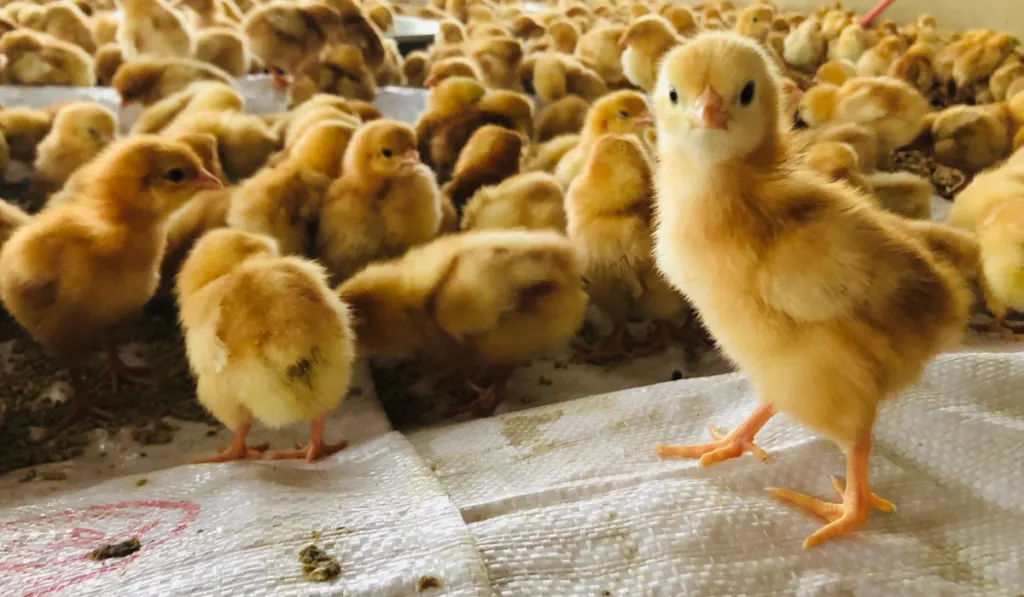
Pros
- Wide Variety
- You choose which vaccinations your chicks receive or do not receive.
- NPIP Certificates Available (often necessary for showing).
- You can choose sexed chickens or straight run.
Cons
- More costly than store bought chicks.
- Chicks may die in shipping.
- May lose more chicks.
Livestock Auctions
Most larger agriculture areas will have agriculture auctions where all types of farm animals are sold to the highest bidder. Often these auctions will have baby chicks available for sale as well as adult birds.
Pros
- When there are a lot of chicks at an auction you can usually get them very cheap.
- Fun buying experience
- Can sometimes get brooders and chick feeders at a discount as well
- Can sometimes get a mom with babies eliminating the need for any extra brooding equipment, mom will do all the work.
Cons
- If there are only a few chicks at the auction, they may go for way more than they would if you just bought them at the feed store.
- Unknown health status. You risk infecting your flock if the farm the chicks originated from had any issues.
- Unknown age & chicks
- Usually, unknown breeds or mixed breeds
4-H & FFA Chicken Auctions
Young farmers across America can join clubs like 4-H and FFA to learn responsible animal raising practices from start to finish. Typically, these kids purchase young animals, raise them up, show them and then auction them off. The proceeds benefit the program and can help offset all the costs involved.

You will typically see a wide variety of APA approved chicken breeds. Buying animals from this type of auction is typically more expensive but supports the community and continued education and interest of our young kids in agriculture.
Private Sellers
The thing with chickens is that most people start with one or two and before they know it, they have more chickens than they can handle. Some turn to hatching eggs and selling the babies to pay for their “chicken habit”.
Pros
- Pricing can be competitive.
- Rarer, specialty breeds may be available.
- Older chicks often available to reduce or eliminate brooding time and expense.
Cons
- Flock health can be an issue. To avoid bringing home diseases look for sellers with NPIP certification and who maintain clean facilities.
- Pricing may be more expensive. Private sellers who know that they have rare breeds and/or quality animals will ask competitive pricing for their chicks.
- Chicks are typically not sexed.
Supplies List
Baby chickens are precocious at birth. Within minutes from hatching from the egg they can walk, run, and eat on their own. Still, they will need to be kept warm, safe, and fed the proper foods so that they grow to their full potential.
At a minimum, you will need somewhere to house them for 4 – 6 weeks until they are mature enough to go outside.
Where to House Chicks
Most people have a few great locations for brooding chicks. Any place that is protected from extreme temperature changes, drafts and that is predator proof will work. Here are some of the top brooder locations:
- In the House
- In the Garage
- On a Covered/Screened Porch
- In a Chicken Coop
- In a Tack Shed
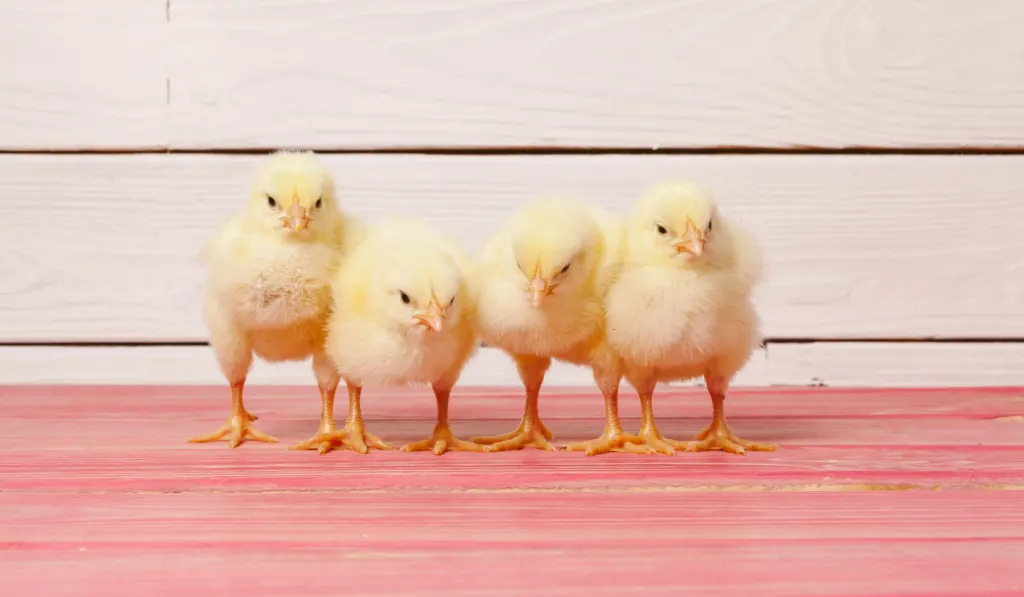
Chick Brooding Supplies
Raising baby chickens requires just a few supplies but, the options found within those few supplies are numerous.
When it comes to raising baby chicks, you need the following supplies at a minimum:
- Cage or brooding pen
- Heat source
- Food & Water Dish
- Bedding
- Chick Grit
- Chick Starter (medicated or unmedicated)
- Roost
Some of these items have so many options they can get confusing, for those, I have more details for you below.
Choosing a Chick Brooder
Depending on the number of chicks you are brooding, your options are pretty open here. The reality is you just need to keep them in an area where they are contained, well fed, watered, and warm.
Chicks need an environment that is draft free in order to thrive but, that doesn’t mean they have to be in the house.
Though, let’s face it, who doesn’t want the cutest little baby chirpers in the house.
When you are picking a chick brooder there are a few things to consider:
- How many chicks are you brooding?
- Are you realistically going to brood more chicks in the future?
- Where are you brooding them?
- What do you have available?
There are many “containers” that work perfectly fine for brooding chicks. The biggest concern is corralling them so they don’t escape and, providing a heat source that won’t burn the house down.
When it comes to raising chicks, the heat lamp or heat source is the single most dangerous part of the whole setup, so that is the thing you should worry about the most. The rest is easy.
Options for brooding chicks include:
- Large Livestock Watering Troughs
- Rabbit Cages
- Rabbit Hutches
- Ferret Cages
- Chicken Coops
- DIY Brooding Boxes
My recommendation is to use what you have depending on the number of chicks. Triple secure your clamp, make sure there is a fire extinguisher handy and use a temperature switch if necessary.
- 【Raised Perches & Comfortable for Poultry】The raised perch keeps your poultry safe, dry and warm, especially in the rainy cold days. It’s also handy in the heat as they are shielded from the sun and can easily access their nesting boxes without exposure to the harsh light.
- 【Spacious Space & User-friendly Design】58″ chicken coop comes with nesting box, resting box and ramp. Your poultry can lay their eggs in the nesting box. There is sliding door and ramp allows poultry to easily enter the raised housing area. There are timber ridges above the ramp to protects your poultry from slipping back. With the design of gridding door you can watch your pets without disturbing.
- 【Removable tray & Gridding Fences】There is removable bottom sliding tray for easy cleaning. High quality gridding fences provide a healthy poultry lifestyle. With the pitched roof your poultry can run outside even in rainy days. The fences are vital to the ventilation of poultry, they will also protect your poultry from the outside predators.
Most people aren’t brooding a hundred chicks their first try and those that are have specialized setups.
Find a container, box, etc. that is as big as you can, add a heat source, bedding, food, and water.
That’s really all you need for a brooding box.
There are options for raising chicks without a heat lamp but, realistically, unless you run your house very warm, some kind of warming device will be necessary.
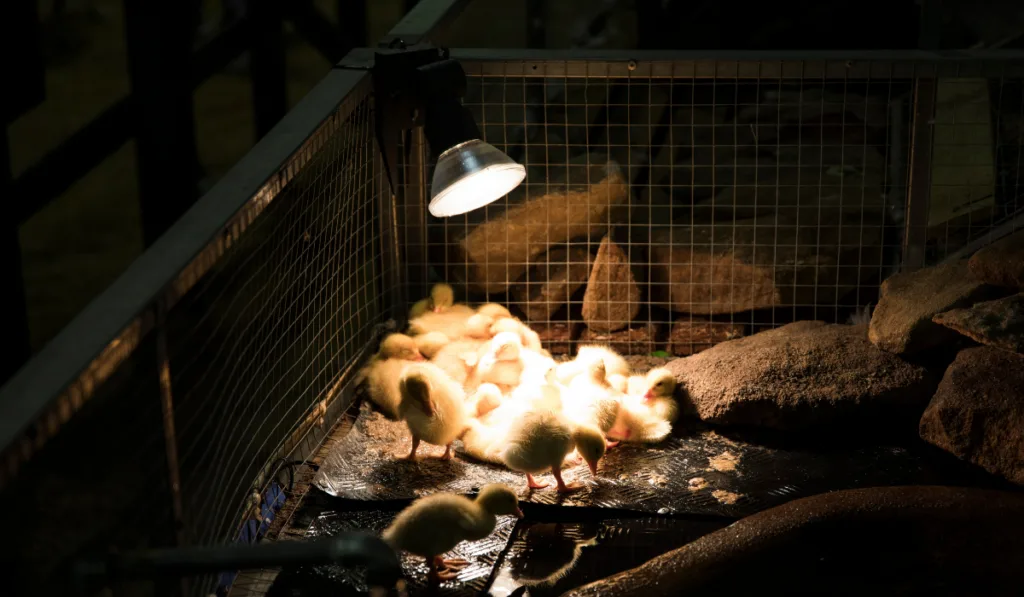
Heat Lamp Options for Baby Chicks
When it comes to providing heat for baby chicks there are three main options.
- Heat Lamp
- Heat Plate
- Heating Pad
Of the three, the heat lamp is the most economical option that is commonly sold for the purpose, it is also the biggest fire hazard.
Heat Lamps

Heat lamps are the standard, and something I have used for years. But I’ve also had close calls where the cat ran into the clamps (2 of them) and knocked the heat lamp into the shavings killings several chicks and causing a potential fire hazard.
I was lucky, there was no fire but I did lose a bunch of chicks and it forever reminded me of the dangers of heat lamps.
Do I still use them? Yeah, but I now triple clamp them to try and ensure they won’t fall into the bedding even in unforeseen circumstances.
You can also set heat lamps on thermostats to help reduce risk.
Heat Plate

Heat plates have become more popular in the past 5 years or so because they seem to be safer in regard to fire danger. Of course, any heat source can be an issue but these less so than heat lamps.
The benefit of a heat plate is that it also provides a cozier environment for the chick. The height is adjustable as the chicks grow. The big thing is to get one that will accommodate your day-old chicks as well as be big enough to keep them warm as they grow.
Heating Pad

Heating pads are more commonly used for reptiles and not so much chickens. Warmth is important and, if It is all you have, you can utilize a heating pad and a feather duster to try and keep your chicks warm.
Truth be told, overhead heat is much better than heat under the chicks. It’s too hard to balance not burning their feet, being safe with wood-based bedding, and providing the body warmth they need.
Sure, if you add a feather duster it will work in a pinch but, so will a hot water bottle.
Heating pads should be a last resort until a proper chick heating source can be attained.
Can you raise chicks without a heat lamp?
It is possible to raise chickens without a heat lamp. You would need to provide an alternate source of heat for the chicks. This could be a hot water bottle, heating pad, etc.
Check out our article on how to raise chicks without a heat lamp for more details.
Food & Water
Chicks need chick starter to grow properly. Adding chick grit after a couple of weeks is good as well.
When it comes to chick starter though, it can be hard to know which type to get. There seem to be so many options. Here are some of the most common things you need to decide when purchasing chick food.
Feed Dishes
You will usually see three types of chick feeders available.
- Round Jar Feeder: These can be plastic with the jars attached or, you can also use a glass mason jar. As chicks eat, additional food drops down from the jar to ensure chicks always have food. Typically, there are round holes to provide chicks with their own private eating space.
- Rectangular Feeder: These are the long, tray style feeders . They also have round holes that can accommodate more chicks at once. They do not auto fill and must be checked and refilled frequently.
- Pan Feeder: This type looks like the round jar feeders with a hopper for food but has just a pan at the bottom that is open and available, so the chicks do not need to stick their head in a hole to access the food.
Since there are so many options, which is the best one. It really depends. Personally, I like the round jar feeders just fine.
- 🐣 Feeder & Waterer Combo for Use In Most Chick Brooder Designs
- 🐣 Feeder Base Designed To Keep Chicks From Scratching Out or Standing In Feed
- 🐣 Shallow Water Base Design Helps Keep Chicks Safe (7/8″ bowl depth)
- 🐣 Includes 1 Quart Size Feeder (9.25″ H) & 1 Quart Size Waterer (8″ H)
- 🐣 For Use With Up To 15 Chicks Till 3 Weeks of Age
I know my baby chicks always have food available and I can keep an extra one on hand to make feed changes quick and easy.
Having raised thousands of chicks, I don’t recommend the rectangular feeders. I have no doubt hundreds of thousands of chicks have used them without issue but I have had several chicks wind up inside the feeder.
Due to that experience, I prefer feeders that stay full which doesn’t usually allow a big enough gap for the chick to have to reach through far enough that it might go into the hole and get stuck.
Chick Watering Dishes
For watering options there are again two main kinds.
- Mason Jar Waterer: Much like the feed jars, these have a base that screws onto a plastic jar or mason jar. You simply fill the jar with water, invert, and your chicks have a ready supply of water.
- Nipple Systems: These are a little more ‘high tech’ as chicken watering options but can really save bedding due to water spills and require less frequent filling. They also make great adult chicken waterers as well.

I love both systems. The jars are just easy and, just as with the food dishes, you can keep a few extra on hand to swap into the brooder when necessary.
The biggest con of the mason jar waterers is that when they tip over, all the water spills out and will require a complete bedding change. The convenience factor still far outweighs the cons though.

As far as nipple waterers for chicks, they work great but, can be difficult to install/setup for a newbie. I love them outside for my chickens but, I still use the mason jar waterers for my chicks.
Chick Food
Chicks should be fed a chick starter with 18-20% protein for the first 4-5 months of life. The higher protein enables them to grow and gives them a strong start in life.
Chick starter typically is available as:
- Chick starter
- Chick crumbles
Typically, the formulation between the two feeds is the same. They are both “starter feeds” but chick crumbles tend to have larger, granular looking pieces compared to chick starter.
Either is a perfectly suitable option. I personally prefer crumbles because I feel like the chicks have an easier time finding and picking up the bits that fall out of their feeder.
Chick Treats
Like most animals, chicks love a good treat. There are many healthy options for chick treats. These include:
- Scrambled Eggs
- Boiled Eggs
- Alfalfa Hay
For more awesome ideas, check out our article 9 Treats Your Baby Chicks Will Love.
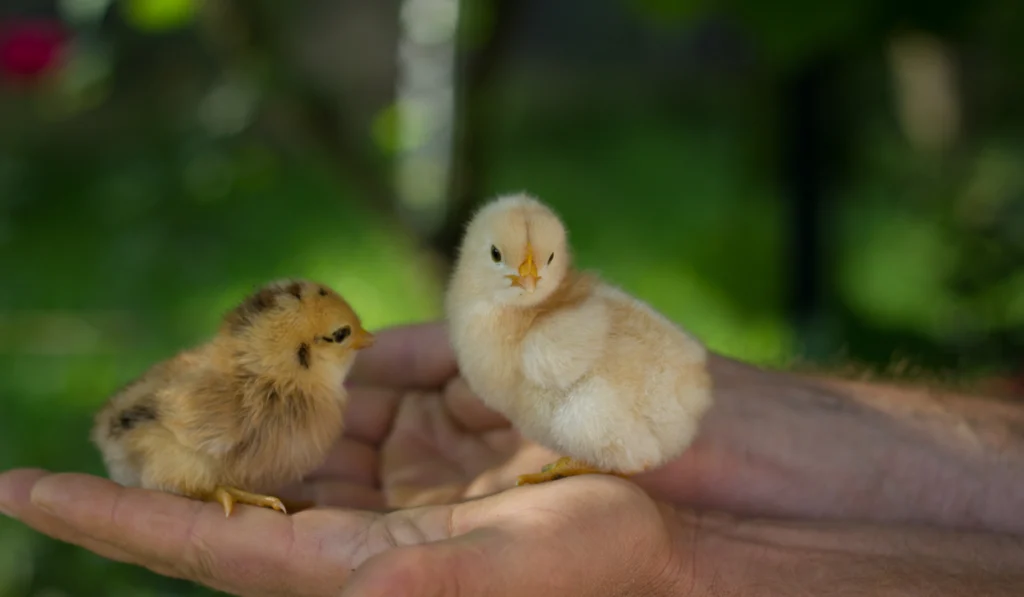
Medicated vs. Non-Medicated Chick Starter
Baby chicks are especially susceptible to a disease called coccidiosis. It’s a very common parasite that can affect chickens of any age but young chicks are especially susceptible.
Medicated chick starter preventatively treats for coccidiosis by targeting the parasite with a substance called amprolium which targets the parasite directly.
Amprolium, the active ingredient in most medicated chick starters, is not an antibiotic. Chicks fed medicated chick starter are still “antibiotic free” unless treated with an antibiotic separately.
There is a vaccine available for coccidiosis. Many hatcheries will administer the vaccine if requested to any chicks being shipped.
The choice of whether to vaccinate or not is a personal decision. In order to prevent losses due to coccidiosis, it is important to choose the correct feed option for your chicks.
Medicated Chick Starter
Medicated chick starter is for chicks that have not been vaccinated for coccidiosis. It will help ensure they do not succumb to the parasite if it is present in the environment.
Non-Medicated Chick Starter
Non-medicated, or “organic” chick starter, is for chicks that have been vaccinated for coccidiosis. Feeding vaccinated chicks medicated feed can have a cancellation effect and leave your chick vulnerable to the disease.
This is an example of where too much of a good thing can be bad.
Chick Ages & Growing Stages
Unless you hatched chicks yourself or ordered them direct from the hatchery, you may be wondering how old your chicks actually are.
When chicks arrive at the feed store, they are typically only 1 or 2 days old but, depending on demand, they may have been sitting there a few weeks before you purchased them.
It is only natural to want to know how old your chicks are for sentimental reasons (trust me, chicken birthdays are a thing…at least in my house!), but also for practical reasons like brooding temperature and preparing to transition them outside.
For most of your large fowl breeds, except broilers, you can make a rough guess based on the feather development of the chick.
Keep in mind though, that these are just general estimates. Some breeds are known to be slow feathering, and some get their feathers much faster. So while this should give you a general idea, your chicks may not fit this timeline exactly.
Birth – 1 Week
- Heat: Yes, Always available.
- Temperature: 95 Degrees Fahrenheit
- Food: Free choice chick starter
- Time Outside: No. At this stage they are very vulnerable to temperature changes and without mom available, it’s best to keep them inside.

When chicks are born, they have the cutest fuzz all over their bodies. During the first week of life, a chick will be starting to show signs of growing real feathers at the tips of their wings.
1 – 2 Weeks
- Heat: Yes, always available.
- Temperature: 90 Degrees Fahrenheit
- Food: Free choice chick starter
- Time Outside: 10-15 minutes if desired, during the hottest part of the day.
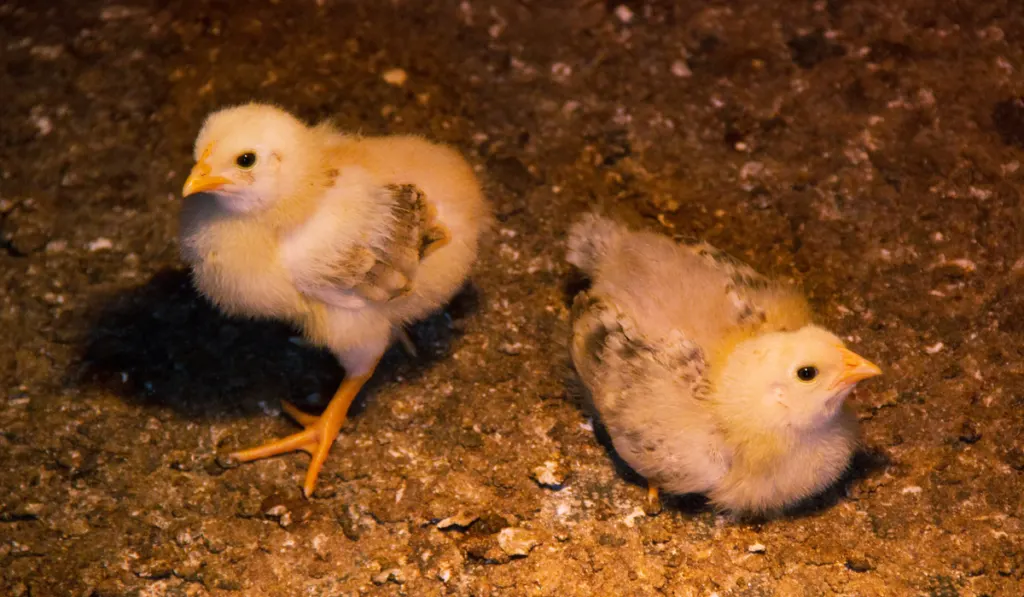
At this age, wing feathers are starting to develop more fully. Some breeds of chicks will likely have all their long wing feathers and the shorter ones at the middle of the wing will be starting to come in.
A few of the feathers on the chest will be starting to poke out. You may start to see tail feathers coming in at this point too.
2 – 3 weeks
- Heat: Yes, always available.
- Temperature: 85 Degrees Fahrenheit
- Food: Free choice chick starter
- Time Outside: Limited to hot days with low drafts.
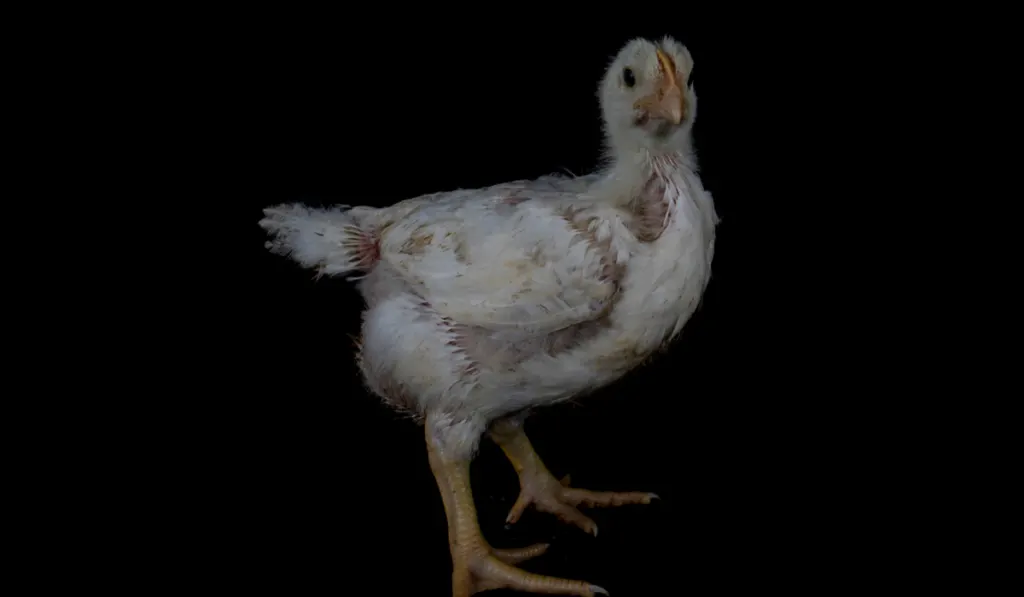
At this stage, baby chicks should have quite a few tail feather shoots developing as their tail starts to fill out. Their wing feathers are mostly all in though they may still have some baby fuzz right up at the tops of their wings.
The tail feathers are starting to become more defined and you’ll notice that they are starting to get some real feathers on their back too.
3-4 Weeks
- Heat: Yes, always available.
- Temperature: 80 Degrees Fahrenheit
- Food: Free choice chick starter
- Time Outside: Limited to hot days with low drafts. They should be monitored for signs of being too cold or provided with a heat source outside.
Now we are starting to see more breast feathers coming in. The chicks heads and tops of their bums will still be fuzzy but tail feathers are becoming more pronounced and wing feathers should all be in.
4-5 Weeks
- Heat: Yes, as needed.
- Temperature: 75 Degrees Fahrenheit
- Food: Free choice chick starter
- Time Outside: Yes, depending on weather. On warm days they can stay out most of the day if they have a place to get out of any wind and also shade if it gets too hot.
At this stage, your chicks should be enjoying some time outside in a secure coop if they have not already. They do not need heat all the time unless its particularly cold or drafty and can start to learn how to peck and scratch outside.
If you are raising chicks in winter, or have some cold and rainy days, you will want to keep them inside but, otherwise its usually pretty safe to have them outside during the day on nice days.
This week most breeds will have at least 90% of their breast feathers in and all of their back feathers. The tail will still be a work in progress but making good progress on filling out.
5-6 Weeks
- Heat: Yes, as needed.
- Food: Free choice chick starter
- Temperature: 70 Degrees Fahrenheit
- Time Outside: Can be outside on nice days depending on weather. Should have protection from wind as well as shade available. Starting to transition to living outside.
At this stage most large fowl chicks are getting big enough to where it’s time to start making the decision to transition them outside. As we go into detail below, this depends on a few factors.
Your chick should be pretty much fully feathered at this stage. She may have some baby feathers still around her head and face, but she definitely looks like an adolescent chicken.
6-8 Weeks
- Heat: Not usually required.
- Temperature: 65 Degrees Fahrenheit
- Food: Free choice chick starter
- Time Outside: Can be outside all day depending on weather. Should have protection from wind as well as shade available. May be able to stay out at night as well.
Between six to eight weeks of age slower feathering breeds will be filling out and catching up to their fast-feathering peers. Some breeds, like silkies, are just going to take longer to get their “adult” feathers in.
Transitioning to Outside
Raising baby chicks in the house is fun. It is an experience you and your kids will remember for years but, at some point, they have to go outside.
So how do you figure out when baby chicks can go outside?
Baby chicks are usually able to live outside in a chicken coop between 5-8 weeks old depending on temperature, housing environment, and the presence of adult feathers.
The big concerns for them is the ability to get warm during the coldest parts of the night. At a young age, they will instinctively huddle for warmth.
Signs that your baby chicks are ready to live outside include:
- All adult feathers are present.
- Nighttime temperatures not below 60 degrees Fahrenheit
- Chicken coop available to protect the chicks from drafts, rain, and heat.
It is impossible to give an exact age for transitioning chicks outside because it really depends on how your chicks are feathering, the temperature in your area and the coop you have setup for them.
For chicks that are new to living outside, if you have severe swings in temperature, you may want to consider bringing them back into the brooding environment or providing hot water bottles or supplemental heat for any abnormal drops in temperature.
Once they are five to six months old, they should be able to withstand changes in temperature like the rest of your flock.
Telling Gender
When you buy chicks there are three common types or classifications according to gender. These are:
- Straight Run
- Sex Link
- Sexed
Straight Run
Straight run chickens are sold as they hatch out of the egg. No gender selection has been performed on the chicks and you should expect 50% female and 50% male chicks.
Sex Link
Sex link chicks are specifically bred so that male and female chicks are clearly identifiable at birth. These chicks are typically created by crossing two different purebred chickens for which the coloring is sex linked.
Males will appear one color and females another. Some common sex link breeds include:
- Red Star or Red Sex Link. Female chicks are red, males are yellow/white.
- Black Sex Link. Females are black, males are barred.
- Autosexing. Some purebred breeds are auto-sexing so you can tell the gender of the chick as soon as it is born.
Sexed Chicks
Hatcheries, knowing that female chicks are more valuable than male chicks, often employ individuals who have developed a skill for sexing chickens.
With reasonable accuracy, they can identify whether a chick is male or female by examining the genitalia of the chick at birth.
The sexers are human, though, and while they are relatively accurate, occasionally there is a mistake. I have ordered hundreds of sexed chicks, though, and never had one not be the gender I ordered.
If you are purchasing chicks from a hatchery, you will certainly know what you are ordering. From a feed store or private buyer, always assume you are getting straight run chicks unless otherwise advertised.
It is quite common for feed stores to order sex linked chicks, knowing that most customers do not want roosters.
Of course, it only matters if you are raising chickens for age. If you are purchasing broiler chickens or any other breed for meat, gender does not really play a role in making purchasing decisions.
Feather Sexing
Some breeds of chicks can be sexed based on their feather pattern very close to birth. These birds have been bred specifically for this feature.
While many will claim that you can feather sex chicks of any breed, this is simply not the case.
Common Diseases & Health Issues
If you have ever lost a chick the first thing you probably asked yourself was “Why did my chick die?”.
This is a very important question because the answer can help you do what you can to ensure the other chicks in the group won’t face the same fate.
There are three main causes for death in chicks:
- Congenital Issues
- Temperature
- Disease
Congenital Issues in Chicks
In any baby, it is possible for them to be born with issues that are not a product of the environment or the way they are being raised. These issues can be benign, like an extra toe, or they can be life threatening.
In most farm animals, this presents as a case of what is known as “failure to thrive”. That basically means that the baby isn’t doing well but disease isn’t suspected and husbandry (temperatures/environment) was good.
In some cases, when warranted, a post-mortem examination can be attained in order to confirm this diagnosis and figure out exactly what was wrong.
In chickens though, that cost isn’t usually worth it.
For peace of mind it is important to know that even if you do everything right, it is possible to lose chicks due to congenital issues.
Temperature
The younger the chick the more susceptible they are to temperature fluctuations and being too cold or too hot can kill young chicks very quickly.
This is why having a heat source is so important. But not just having the heat source, placing it in a way that chicks can move closer to the heat to get warm or move further away to get cool.

Chicks will naturally regulate their own temperature. Small brooders often have the risk of being too hot if there is not sufficient space to get away from the heat source.
This is less of an issue with heat plates and much more common with overhead heat lamps.
How to Tell if Chicks are Too Cold

Chicks that are too cold will huddle together as close to the heat source as possible in order to try and get warm.
Signs your baby chicks are too cold:
- Huddled together under the heat source
- Chirping loudly
How to Tell if Chicks are Too Hot

Chicks that are too hot will do their best to try and regulate their body temperature by spreading out away from the heat source as much as possible.
Signs your baby chicks are too hot:
- Spread Out far away from the heat source
- Panting
- Holding wings away from body
- Quiet
Draft
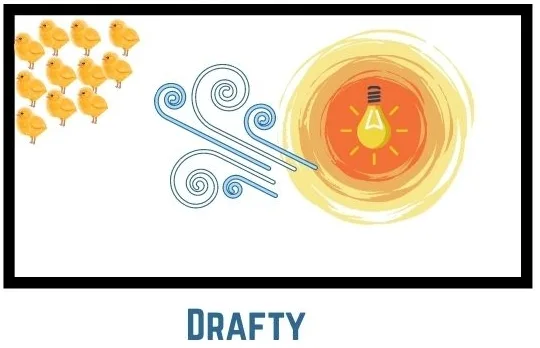
Airflow is important when housing animals, including baby chicks, but when that airflow is too cold or two strong it becomes a draft.
A tell tale sign that there is a draft is that all of your chicks are huddled in one area. Now, this could be that they are too hot as well so you’ll have to observe them to find the cause.
One way to check for drafts is to hang ribbons near the brooder. The movement of the ribbons can help identify where the draft is coming from. If the ribbons are still, a draft is likely not the issue.
Of course, be sure to use lightweight ribbons if using this method.
Signs your chick brooder has a draft:
- Chicks huddled to one side of the brooder
- Temperature seems OK in brooder for age range of chicks
- Otherwise normal behavior
Best Temperature
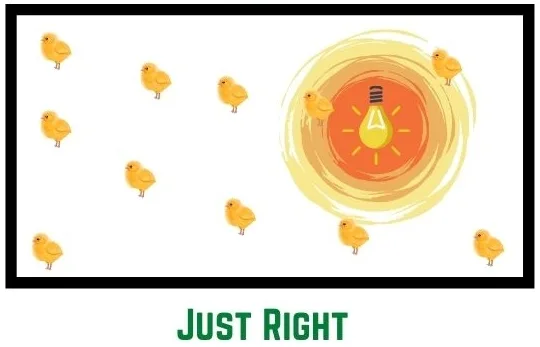
Aside from following the temperature guidelines listed above, you will be able to visually see when you have achieved a comfortable temperature for your chicks.
Baby chicks that are comfortable, not too hot or too cold, will tend to distribute evenly around their brooder. They will go explore when they are warm and be under the light when cold.
Diseases in Baby Chicks
Here are some of the most common issues you may encounter when raising baby chicks.
| Disease | Age | Symptoms | Prevention |
| Aspergillosis | 1 – 6 weeks old | Trouble breathing, fever, weight loss | Thoroughly clean brooders between use, use fresh bedding |
| Avian Encephalomyelitis | >2 Weeks | Stumbling, shivering, paralysis | Vaccine |
| Coccidiosis | >4 Days | Bloody Stools | Vaccine, Medicated Feed |
| Fowl Pox | >1 Week | Scabs, eye swelling, weight loss | Yes |
| Infectious Bronchitis | >1 day | Sneezing, coughing | Yes |
| Marek’s Disease | ≥ 3 weeks | Paralysis, gray eyes | Vaccination of newborn chicks |
| Mushy Chick Disease | 0 – 2 weeks | Navel infection, unabsorbed yolk sac, excess fluid (edema) | Clean incubator and brooder thoroughly between batches |
| Newcastle Disease | >1 day | Trouble breathing, coughing, sneezing, head twisting, paralysis | Vaccination, strict biosecurity practices |
| Pasty Butt | 0 – 10 days | Poop stuck to butt | Stress, diarrhea, overheating, diet change |
| Pullorum | 0-4 weeks | Seek out heat, look weak, diarrhea, loss of appetite | Purchase chicks from NPIP certified sources only |
| Rot Gut | 2 – 5 Weeks | Death, ruffled feathers, diarrhea | Vaccinate for coccidiosis, avoid feed changes |
